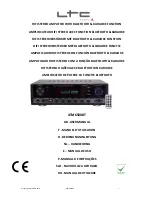
Bosch Security Systems | 2011-02
Praesideo 3.5
| Installation and User Instructions | 9 | System Configuration
en
| 404
49
Automatic volume control
49.1 Introduction
Automatic volume control (AVC) improves the
intelligibility of calls and the audibility of BGM in noisy
environments. It changes the call volume in a zone to
compensate for ambient noise. The ambient noise is
measured by sensing microphones that can be
connected to any of the audio inputs on the power
amplifiers. Although it is possible to connect the
ambient sensing microphone to other inputs of the
system, only the power amplifier inputs provide
microphone supervision. Furthermore, the other inputs
have a built-in audio limiter that will interact with the
AVC, when the signal levels are relatively high, such as
when coming from an electret microphone..
49.2 Sensing
microphones
49.2.1 Introduction
When AVC is enabled in a zone, a sensing microphone
continuously measures the ambient noise. The system
uses an averaging filter to derive the average ambient
noise level from the signal of the sensing microphone.
49.2.2 Type
Use sensing microphones with high-quality cables,
because sensing microphones are often installed in
locations that are hard to reach. It is not required to use
high-quality microphones. The choice for a directional
or omni-directional microphone depends on the local
situation.
49.2.3 Supervision
The connections between the system and the sensing
microphones can be supervised (see section 43.3.3).
When the sensing microphone of a zone fails, all calls in
the zone are distributed at the maximum volume to
comply with evacuation standards. When the sensing
microphone of a zone fails, the attenuation of BGM is
set to AVC range (see figure 49.1). To prevent
undesired supervision faults, make sure that:
•
The supply current for condenser microphones is
between 0.5 mA and 5 mA.
•
The microphone impedance of dynamic
microphones is between 120
Ω
and 1300
Ω
.
49.2.4 Installation
To make sure that the sensing microphone measures the
correct ambient noise level, install it in a place which
has a typical ambient noise level. Furthermore:
•
Keep the cables of the sensing microphones and
high-power cables (e.g. mains cables) separated.
Interference can disturb the ambient noise
measurement.
•
Do not install the sensing microphone near an
expected noise source. A loud and very local noise
can disturb the ambient noise measurement.
•
Do not install the sensing microphone near an air
vent or air conditioning. Airflows can disturb the
ambient noise measurement.
•
Do not attach the sensing microphone to any part of
a building. The vibrations of buildings can disturb
the ambient noise measurement.
49.3 Connection
Sensing microphones can be connected to the unit that
contains the audio outputs of the AVC zone or to
another amplifier. When the sensing microphone is
connected to another amplifier and it is used in
combination with an AVC zone, it permanently
occupies a digital channel. As a result, the number of
digital audio channels that are available for calls
decreases.
49.4 Configuration
Before configuring AVC in a zone:
•
Make sure that the ambient sensing microphone is
correctly connected to the system.
Note
Between the start of a call and the end of a call,
the AVC function does not process the signal of
the sensing microphone.
Note
Spare amplifiers cannot take over the sensing
microphone from a failing main amplifier when
the signal of the sensing microphone is not
routed over the optical network.
















































